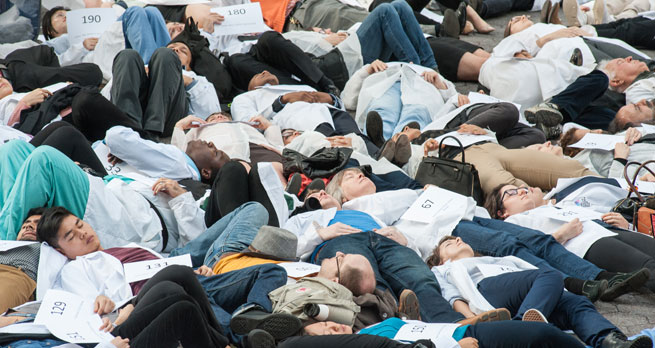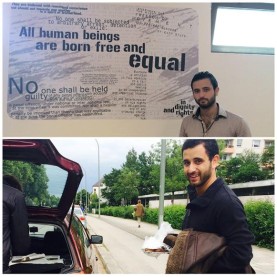 Supporters %u201Cdie%u201D in honor of medical workers killed in Syria at an event in New York City hosted by Physicians for Human Rights and the Syrian American Medical Society.
Supporters %u201Cdie%u201D in honor of medical workers killed in Syria at an event in New York City hosted by Physicians for Human Rights and the Syrian American Medical Society.
Attacks on health workers in Syria have become so frequent that medical relief charities have been forced to build hospitals in bunkers and deep into the side of mountains.
The Syrian American Medical Society (SAMS), which provides medical relief across Syria and to refugees in neighbouring countries, now has 22 underground clinics in Syria. These care for some of the millions of Syrians living in hard-to-reach parts of the country and the 800,000 living in besieged areas, cut off from medical aid and supplies, electricity, telephone lines and food aid.
Ingenuity and resourcefulness are core to these clinics, says Zaher Sahloul, SAMS senior advisor, in this interview. For example, with many power plants bombed out, Syrian hospitals must often rely on diesel-fed generators. But in areas under siege, diesel is unavailable so medical clinics have been testing ways of running generators on methane from animal waste.
Meanwhile, satellite internet and video apps link Syrian doctors, nurses and medical students to medical teams in the United States. “This is the only way we know what is happening and what’s needed,” Sahloul says. “I can look at the patients and talk with the physicians and nurses and [they can] tell me what’s happening and seek advice.”
Doctors, nurses and medical students are also being trained to treat the effects of chlorine gas, a chemical agent used frequently by the Assad regime. Virtual situation rooms, using apps like WhatsApp and Viber, guide health workers through chemical weapon response, from treatment to decontamination. SAMS also provide training in advanced trauma life support and how to use crisis technology like portable ultrasound kits.
The care of the wounded and sick has been protected since the very first Geneva Convention of 1864, but the Syrian conflict has seen the rule book torn up, with attacks on healthcare reshaping conflict and humanitarian response. The story behind one SAMS hospital highlights the shocking “new normal” in twenty-first-century warfare.
SAMS wanted to build the hospital in a city in one besieged area, Sahloul tells SciDev.Net. “But people in the city told them: ‘No way are you going to build a hospital inside the city because that means we will be targeted.’” So the organisation moved it away from the city and dug it deep into the heart of a mountain, where the emergency rooms and intensive care units are served by a 24-metre ventilation shaft.
Overall, SAMS had 72 clinics attacked last year by bombs, missiles and shells. The international relief charity Médecins Sans Frontières (MSF) has stopped sharing hospital locations because of attacks. A new report from the Safeguarding Health in Conflict coalition documents 122 attacks on health centres in Syria in 2015.
“People no longer react when hospitals are bombed, doctors are killed,” Sahloul said in his keynote speech at the MSF Scientific Days on 20 May. “This should not be allowed. Not only in Syria, but [also] in the rest of the world.” The interview was recorded during the MSF Scientific Days.
This article was originally published on SciDev.Net. Read the original article.

Rate and Review
Rate this audio
Review this audio
Log into OpenLearn to leave reviews and join in the conversation.
Audio reviews